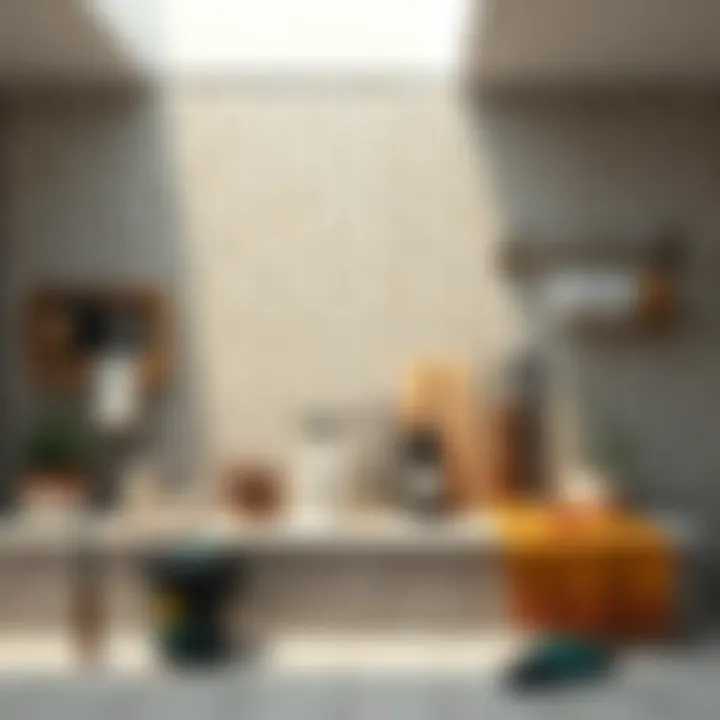Ultimate Bathroom Tiling Guide for Homeowners


Intro
Tiling your bathroom can feel like a daunting task, especially when staring at a blank slate. However, with the right approach, anyone can turn their vision into reality. Not only does tiling enhance the aesthetic appeal of your bathroom, but it also adds durability and value to your home. This guide aims to demystify the process, breaking down the steps and providing crucial insights into choosing the right tiles, materials, and equipment.
Design Inspirations
When embarking on a tiling project, inspiration reigns supreme. The bathroom is often a sanctuary, a personal retreat from the hustle and bustle of daily life. Therefore, crafting a space that feels inviting is key.
Trending Styles
Fads come and go, but certain styles seem to stand the test of time. One such trend gaining traction is the blend of modern and vintage aesthetics. Think subway tiles paired with brass fixtures. They create a chic charm that is both timeless and fresh. You might also consider geometric patterns for a modern flair. These eye-catching designs can transform a simple bathroom into a striking visual spectacle.
Among the popular choices this year, lush textures and organic materials come to the forefront. Natural stone tiles are not only beautiful but also bring a touch of nature inside, promoting a calming atmosphere. For those who prefer a splash of color without going overboard, accent tiles in a bold shade can make a striking statement.
Color Palettes
Choosing the right colors can be the difference between a mundane space and a harmonious escape. Soft, muted tones like seafoam green or blush pink can evoke a sense of tranquility, perfect for a bath meant for relaxing. Alternatively, bolder colors such as navy blue or deep burgundy can create a dramatic, sophisticated ambiance.
When in doubt, a classic palette of whites and soft grays provides an elegant backdrop, allowing for flexibility in accessories and decor.
Remember, the color you choose can drastically influence your bathroom's overall vibe.
Selecting the Right Tiles
Tile selection is crucial. Consider the size and layout of your bathroom. Larger tiles can make a small space feel more expansive, while smaller tiles are great for adding detail to intricate areas such as showers or accent walls. When reviewing options, think about material, finish, and functionality.
Common options include:
- Ceramic: Affordable and available in countless designs, it's a great choice for beginners.
- Porcelain: Known for its durability and water resistance, ideal for high-moisture areas.
- Natural Stone: Each piece is unique, but may require more maintenance.
The choice of grout color can also impact the visual presentation, so select wisely.
Tools and Materials Required
Before diving into installation, gather all necessary tools and materials. Essential items include:
- Tile cutter
- Adhesive
- Grout
- Level
- Sponge
- Sealer
Make sure to prepare your workspace adequately. Clear the area of any clutter and debris, ensuring it’s conducive for the task ahead.
At this point, you're equipped with inspiration and the tools needed. Just remember, patience is key – every step counts toward achieving your ideal bathing oasis.
As we move forth, we’ll explore more technical aspects of installation, diving deeper into the techniques and final touches that will enhance your newly tiled bathroom.
Prelims to Bathroom Tiling
Tiling a bathroom is more than just arranging some pretty tiles; it's a crucial aspect of home improvement that brings together functionality, aesthetics, and durability. With so many materials and designs to choose from, every homeowner can find options that suit their taste and budget. This article delves into the nitty-gritty of how to effectively tile a bathroom, starting with understanding the different types of tiles available and how to prepare your space properly.
Understanding the Importance of Tiling
Tiling isn't merely about making a room look attractive; it plays a fundamental role in protecting the surfaces of your home. Bathrooms are notorious for their moisture levels. Tiling helps create a waterproof barrier, safeguarding your walls and floors from water damage. Additionally, well-installed tiles can offer insulating properties, which can assist in maintaining comfortable temperatures.
Moreover, when it comes time to sell your home, a tastefully tiled bathroom can significantly enhance its appeal, potentially increasing its market value. Customization options allow homeowners to express their unique style, making tiles not only a protective element but also an integral part of the bathroom's overall design philosophy. With the right approach, a simple tiled surface can become a centerpiece that integrates beauty with practicality.
Different Types of Tiles Available
Selecting the right tile for your bathroom can feel like finding a needle in a haystack due to the myriad of choices available. Each type of tile has its own set of characteristics, advantages, and drawbacks. Below, we will break down the four main types of tiles often used in bathrooms, examining their unique features and roles in the tiling process.
Ceramic Tiles
Ceramic tiles are one of the go-to options for bathrooms. They're made from a mixture of clay and other materials, baked at high temperatures to make them durable and water-resistant. What sets ceramic tiles apart is their versatility; they come in a multitude of colors, sizes, and textures. This wide range allows for endless creativity in design.
The key characteristic of ceramic tiles is their affordability, making them a popular choice among homeowners. While they are less dense than porcelain, making them somewhat less durable, their ease of installation and maintenance is hard to snub. One notable advantage is that they do not require sealing like other materials, which simplifies cleaning. However, they can be prone to chipping and cracking if heavy objects are dropped on them.
Porcelain Tiles
Then there’s porcelain tiles—a step up from regular ceramic. Made from denser clay and fired at higher temperatures, these tiles are tougher and more water-resistant than their ceramic cousins. Their key characteristic is their ability to mimic natural stone or wood with stunning realism, offering an upscale look without the associated cost.
The unique aspect of porcelain tiles lies in their low porosity, which not only makes them stain-resistant but also ideal for bathrooms where spills are common. One disadvantage is that they can be more challenging to cut, requiring specialized tools. However, their durability and resistance to moisture more than make up for this complexity.
Natural Stone Tiles
Natural stone tiles, such as granite, marble, and slate, bring an element of luxury to any bathroom. The important aspect of natural stone is its uniqueness, as no two pieces are exactly alike. This inherent beauty allows for breathtaking designs that can elevate the aesthetics of your bathroom to new heights.
However, they do require regular sealing to prevent staining and moisture penetration, which can be a bit of a hassle. Despite this responsibility, the durability and timeless appeal of natural stone tiles are undeniable—offering a classic elegance that many homeowners desire. They are often seen as a long-term investment in your home’s value.
Vinyl Tiles
Last but not least, vinyl tiles represent affordability and practicality, making them a sensible choice for budget-conscious homeowners. Made of synthetic materials, vinyl tiles are available in a variety of designs, including those that mimic stone or wood. They are easy to install, often featuring peel-and-stick options that anyone could manage.
The significant advantage of vinyl tiles is their comfort underfoot and ease of maintenance. They're resistant to moisture, making cleaning a breeze. However, they might not have the same visual impact as stone or high-quality ceramics, and they typically do not last as long in heavy-use areas. But for someone looking to renovate without breaking the bank, vinyl tiles can be the perfect solution.
Planning Your Tile Project
Planning your tile project is the cornerstone of a successful bathroom tiling endeavor. Getting this part right sets the tone for everything to follow. If you don’t plan carefully, you might find yourself in a sticky situation where the tiles don’t fit, or you run short on materials mid-project. A good plan helps you save time, money, and your sanity.
Assessing Your Bathroom Space
When you're dealing with a bathroom space, it’s crucial to evaluate its dimensions and layout before diving into the tile selection and installation processes. Every bathroom has its own quirks, be it the nooks and crannies or the way the light falls on the surfaces. Measurements are your best friend here.
Start by taking exact measurements of the floor, walls, and any other areas you plan on tiling. This isn’t just about knowing how much tile to buy; it’s about visualizing how the space will turn out. Some common characteristics to consider include the overall shape of the bathroom, the height of the walls, and whether there are any fixtures like vanities or bathtubs that may complicate tile placement.
Calculating Required Materials
Once you have a handle on the space, the next step is calculating the necessary materials. This ensures you order the right quantity of tiles, grout, and adhesive, avoiding potential hiccups later on.
Measuring the Area
Measuring the area involves more than just the square footage. It requires careful consideration of the floor’s layout. If your bathroom has awkward angles or cut-ins, those all need to be accounted for. When calculating, remember to measure each section separately, especially if they differ in size.
- Key characteristic: Accurate measurements ensure that you don’t end up with too many or too few tiles, saving you time and avoiding wastage.
- Unique feature: Using a laser level can make your work easier, providing precise readings that a traditional tape measure might miss.
The overall benefit of meticulous measuring is an efficient and visually appealing layout. Having a clean tile arrangement significantly enhances the bathroom’s aesthetic, leading to a professional-looking finish.
Estimating Waste


Estimating waste is one of those steps that many people overlook but is absolutely vital. It involves accounting for the tiles that might get damaged during installation, require cuts for edges, or any that simply don’t match the design once laid out. A common rule of thumb is to add an extra 10-20% to your final tally based on your measurements.
- Key characteristic: This estimation prevents you from having to run back to the store mid-project, which often results in mismatched shades of tiles.
- Unique feature: Some tiles may have pattern designs that affect how waste is calculated. For example, if you're using a patterned tile, it may require more careful cutting, thus increasing the waste factor.
By accurately estimating waste, you buffer against unexpected mishaps, making your tiling experience smoother. This little step can save you quite a bit of heartache in the long run.
Essential Tools for Tiling
When it comes to tackling a tiling project in your bathroom, the right tools can mean the difference between a professional-looking finish and a disaster. Having the essential tools on hand not only streamlines your workflow but also ensures safety and precision in every step of the installation process. Knowing how to use each tool effectively enhances your overall efficiency and minimizes the chances of costly mistakes.
Basic Tools Needed
Tile Cutter
A tile cutter is an indispensable tool when it comes to achieving accurate and clean cuts in tiles. This tool is designed specifically for slicing through ceramic or porcelain tiles with ease, and its significance cannot be understated. A key characteristic of a tile cutter is its scoring mechanism, which allows you to create a clean break without chipping the edges – this is crucial for maintaining a polished look in your bathroom.
One beneficial aspect of tile cutters is that they come in both manual and electric varieties. The manual ones, though slightly less convenient, are often more affordable and great for smaller jobs. On the other hand, electric tile cutters, while pricier, offer more power and can tackle larger projects effectively.
However, one disadvantage of relying solely on a manual tile cutter is the physical effort required, which can be tiring on larger jobs. Always ensure you are comfortable using whichever style you choose to avoid frustration and fatigue during installation.
Trowel
A quality trowel is vital for spreading mortar evenly before laying down tiles. The right trowel helps ensure that your adhesive is applied in an even layer and reduces the likelihood of tiles slumping or shifting. A distinct characteristic of trowels is their notched edges, which help create ridges for better adhesion.
Using a notched trowel not only enables you to control the amount of adhesive used but also improves the bond between the tile and the substrate. When selecting a trowel, consider its size and notch shape – these factors can affect how much thinset you are applying. Keep in mind that a larger tile requires a larger trowel with deeper notches for optimal adhesion. However, overuse can lead to a cluttered workspace, so be judicious in your approach.
Level
A level is essential for checking the alignment of your tiled surface. It ensures that each tile rests flush, supporting a coherent final appearance. A key feature of a level is its bubble vial, which indicates whether the surface is perfectly horizontal or vertical. Investing in a good quality level is important for achieving a professional finish, as uneven tiles can result in not just an unsightly look, but also potential water pooling issues that might lead to further complications.
Using a level during layout planning helps prevent misalignment when setting tiles. It’s not only useful for determining the flatness of the subfloor, but it also guides you in making adjustments along the way. However, always look out for tiles that may not align well even with a level – these can be indicative of underlying issues worth investigating!
Safety Equipment
Using safety gear while tiling protects against common hazards associated with the installation process. From sharp tile edges to dust generated from cutting, ensuring that you are well-protected should not be overlooked in any tiling project.
Gloves
The primary purpose of gloves during tiling is to protect your hands from cuts and abrasions when handling tiles and tools. A notable characteristic of good gloves is their grip, allowing you to hold tiles securely without the risk of them slipping from your grasp. It is recommended to choose gloves made from durable materials like leather or reinforced synthetic fabrics.
A unique feature of gloves is that they come in various thicknesses. Thicker gloves offer better protection but can reduce dexterity, while thinner gloves allow for more tactile feedback but offer less protection. Ultimately, choosing the right pair balances protection with functionality coud be tricksy.
Goggles
Goggles serve to shield your eyes from flying debris when cutting tiles, and they are essential for ensuring safety during the tiling process. The key characteristic of goggles is their snug fit around the eyes to prevent dust or small pieces from accidentally making contact with your vision.
A major advantage of using goggles is their ability to provide comfort without compromising visibility. However, sometimes they can fog up during use, so look for vented options that minimize this issue while maintaining a clear line of sight.
Dust Mask
A dust mask is vital when working with tiles, particularly when cutting. This protective gear helps prevent inhalation of dust and particulates, which, in excess, can cause respiratory problems. The main feature of a quality dust mask is its filtration capability, protecting your lungs from harmful particles.
While using a dust mask is a simple measure, its impact on your health during the tiling process is significant. However, ensure that your mask fits properly to avoid any exposure – ill-fitting masks can become a nuisance, leading to discomfort when trying to work.
"Using the right tools isn't just about convenience; it’s about achieving a finish you'll be proud of for years to come."
Epilogue
Equipping yourself with the appropriate tools and safety gear is a foundational step in any tiling project. Whether you're a seasoned DIY enthusiast or just starting out, investing in quality tools not only simplifies the tiling process but also enhances performance and safety in your workspace. It is important to remember that taking the time to prepare is just as critical as the installation itself. Always consider your choices carefully and prioritize quality – your bathroom tiling project deserves nothing less.
Preparation Steps Before Tiling
Before diving into the tiling process, a few preparation steps can make a world of difference. These initial tasks lay the groundwork for a successful tile installation, ensuring longevity, beauty, and functionality. A meticulous preparation routine sets the tone for your project and addresses potential headaches down the line. Here’s a look at the key elements that are absolutely essential in this stage.
Cleaning the Surface
Cleaning the surface where the tiles will be applied isn’t just a trivial chore; it’s a non-negotiable part of the prep work. A clean surface ensures that tiles adhere properly, preventing issues such as peeling or offset joints later. Dust, dirt, and moisture can wreak havoc on your installation, so take this step seriously.
Start by sweeping and vacuuming the area to remove loose debris. After that, you might want to wipe down surfaces with a damp rag. Depending on the previous floor covering, you may need a more aggressive cleaning solution to eliminate old adhesive or grime. Using a degreaser can also be beneficial, especially in high-moisture areas typically found in bathrooms. Remember, a clean canvas ensures that the tiles can be set firmly and will stay in place for years to come.
Smoothing and Leveling the Subfloor
A level subfloor is critical for a successful tiling outcome. An uneven base can lead to cracks in tiles or even breakage due to pressure. Here are two significant actions to focus on:
Identifying Uneven Areas
Identifying uneven areas in your subfloor means more than just a quick glance. It involves checking for dips and high points often hidden beneath old flooring or beneath layers of grime. Use a level or a long straightedge; this will help you see any discrepancies clearly. Often, homeowners overlook this step, assuming their floors are sufficiently level.
The big takeaway here is that if you find unevenness, you’ll be setting yourself up for failure if you don’t address it. In a bathroom where water is prevalent, having a flat floor prevents water pooling, which can lead to mold and other unwanted issues. This identification process could involve a bit of elbow grease, but the effort pays off in the long run by saving time and potentially, money.
Applying Self-Leveling Compound
Should you find uneven areas that need addressing, using a self-leveling compound is a popular choice among DIYers. This versatile material is designed to fill in low spots and create a smooth, uninterrupted base for your tiles. What makes self-leveling compound an appealing option is how straightforward it is to apply. Just mix it according to the manufacturer’s instructions and pour it onto the floor, allowing gravity to do the rest.
One of the unique features of self-leveling compound is its quick drying time, which minimizes downtime for your project. However, it’s crucial to be vigilant about following the instructions meticulously, as improper mixing or application can lead to subpar results. On the flip side, its quick and effective smoothing capabilities make it a valuable ally in your tiling project.
In summary, taking adequate time to clean the surface, identify uneven areas, and apply a self-leveling compound if necessary prepares your bathroom for a flawless tile installation. With proper groundwork laid down, you’re ready to proceed seamlessly to the next steps of your tiling journey.
Tile Layout Planning
Planning the layout of your tiles can make or break the overall look of your bathroom. It's not just about admiring pretty tiles; it’s about how they fit together and how they relate to the space that you are working with. Proper tile layout influences both the aesthetic appeal and the functionality of the area. Having a well-thought-out tile design means less cutting and wastage, and it also helps in achieving a seamless, polished look.
Here are some key benefits and considerations when planning your tile layout:
- Visual Appeal: Different layouts can create various impressions of size and space. A good layout can make a small bathroom appear more spacious.
- Flow and Movement: How the tiles are arranged can guide the foot traffic in your bathroom. A harmoniously laid-out tile system ensures comfort and ease of movement.
- Wastage Reduction: Being mindful of layout means less time cutting tiles and a reduced chance of running out mid-project.
Taking the time to thoughtfully plan your tile layout is crucial. Now, let's delve into some popular tile patterns that can help you achieve the desired effect.
Choosing a Tile Pattern
Straight Lay
A straight lay, where tiles are set in a straightforward parallel grid, is one of the simplest and most classic methods. This layout is especially appreciated for its clean lines and easy installation, making it a favored choice among DIYers. The primary characteristic of the straight lay is its uniformity, which provides a sense of order and structure to any space.
Key benefits of a straight lay include:


- Ease of Installation: Perfect for novices or anyone looking for a straightforward project.
- Widespread Availability: Most tile designs come ready for a straight lay, ensuring that you can find a variety of options.
- Versatility: It’s suitable for both contemporary and traditional styles, adapting well to various aesthetics.
However, while it’s often seen as a safe choice, the straight lay may lack the visual interest found in more intricate designs. Still, its simplicity can be pretty stunning when done right.
Diagonal Lay
The diagonal lay involves placing tiles at a 45-degree angle to the walls. This pattern brings a unique twist that can create dynamic visual effects, adding to the liveliness of your restroom. One of the most appealing aspects of the diagonal lay is how it plays with light; the angled tiles reflect and refract it beautifully.
This approach has its perks:
- Appears Bigger: Diagonal designs tend to trick the eye, making the space feel larger and more open.
- Aesthetic Interest: It’s a lively alternative to traditional layouts, adding character to the room.
That being said, it's worth mentioning that the diagonal lay can be more challenging than the straight variation. It requires precise measurements and might lead to slightly more cutting, which is something to keep in mind when planning materials.
Herringbone
Herringbone is a classic pattern that resembles the bones of a fish, characterized by zigzagging tiles. This arrangement offers a very rich texture and is particularly captivating in smaller spaces where you want a focal point.
The herringbone layout stands out for several reasons:
- Intricate Design: This layout is visually stunning, creating a sense of depth and movement.
- Style Statement: Using herringbone tiles can give your bathroom a more luxurious and high-end feel.
However, with great beauty comes great intricacies. Installing a herringbone pattern can be time-consuming and usually requires precise and careful alignment to maintain its iconic shape. This layout is better for those who are confident in their tiling skills or wish to hire a professional to execute this design.
Creating a Dry Layout
Creating a dry layout before you start installing the tiles is a recommended step to visualize how the finished floor will look. Simply lay out the tiles without adhesive, arranging them in your chosen pattern to assess how they will fit in your space. This will allow you to make adjustments as needed, ensuring a complementary fit and visual alignment before you commit with mortar.
Applying Mortar and Setting Tiles
When it comes to bathroom tiling, applying mortar and setting tiles are foundational steps that can significantly influence the final outcome. Mortar acts as the adhesive that secures your tile to the surface, ensuring they stay put for years—provided it’s mixed and applied correctly. Improper application can lead to cracks, loose tiles, and increased likelihood of water damage.
The process requires attention to detail and an understanding of how different types of mortar interact with various tiles. Marginal mistakes in these stages can lead to a cascade of issues down the line, making this part both crucial and rewarding if done correctly.
Mixing the Mortar
Mixing mortar isn’t just playing in a sand pit; it’s about creating a strong bond. The type of mortar you choose can vary based on the tiles you’re using and the room conditions. For instance, thin-set mortar is a popular choice for standard bathroom tiles, while thicker mortars are ideal for larger slabs. Understanding water ratios and mixing times will get you a product that’s neither too runny nor too thick, which can compromise its adhesion ability.
Before mixing, it’s essential to read the instructions on the bag. Each brand has its specific requirements, and following them will save you from a world of trouble later.
Applying the Mortar
Using the Trowel
When it comes to using the trowel, think of it as your dedicated partner in crime. The trowel’s not just any tool; it’s designed to create a uniform layer of mortar that ensures stability. Its serrated edge is what does the magic, helping to distribute the mortar evenly.
- Key Characteristic: The different sizes of trowel notches have a profound effect on how much mortar is applied. For example, a larger notch creates more depth, while a smaller notch allows for a thinner layer.
- Advantages: Using a trowel gives you more control. The way you angle your trowel can also make a massive difference in how the mortar spreads. You can attain that perfect texture that maximizes glue to tile surface area.
While you can certainly apply mortar with another method, the trowel is tried and true. It allows for the precision needed when laying down tiles, especially in tight spots next to other fixtures.
Spacing Tiles Correctly
Don’t be fooled; spacing tiles correctly is more of an art than it seems. It’s tempting to lay tiles just to get the job done, but the eye for consistent spacing is what separates a novice from a professional.
- Key Characteristic: Tile spacers maintain an even gap between each tile—something crucial when it comes time to grout. Those little bits can go a long way in ensuring a polished look.
- Advantages: Correct spacing not only enhances aesthetics but also allows grout to be applied evenly, preventing potential cracking due to uneven surfaces. If you mix different tile sizes, you’ll find that this aspect becomes even more critical.
Setting the Tiles
When you’re ready to set the tiles, the work you did with mortar and spacing reveals its significance. You want to press each tile into the adhesive with just the right amount of pressure, so they’re secured without oozing out too much mortar. Start in the center of your layout and work outward to maintain symmetry.
As you lay each tile, remember to adjust for those spacers and consider patterns or designs you might want to incorporate. Each placement should feel deliberate; if something looks off, don’t hesitate to pull it up before the mortar sets.
Finishing strong means ensuring every tile is clicked into place just right—an effort that pays off tremendously once you step back and admire your handiwork. Taking your time at this stage can define the aesthetic appeal of your newly tiled bathroom.
Cutting Tiles for a Perfect Fit
When it comes to tiling your bathroom, the importance of getting the tiles cut to the right size cannot be overstated. Cutting tiles for a perfect fit is crucial because it directly influences not only the aesthetic appeal of the space but also the overall functionality. If tiles don’t fit properly, you might end up with uneven surfaces, gaps, or other issues that can lead to water damage or a less polished look.
Using a Tile Cutter
A tile cutter is an indispensable tool for anyone attempting a bathroom tiling project. While you may be tempted to think that all tile cutters are created equal, this is far from the truth. There are various types of tile cutters available, including manual and electric models.
- Manual Tile Cutters: These are straightforward to use and are ideal for ceramic tiles. After measuring and marking your tile, align it on the cutting surface, then apply pressure on the handle to score a line on the tile. This method ensures you have a clean break. The simplicity of a manual tile cutter makes it a favorite among DIY enthusiasts, but keep in mind that it may not suit thicker tiles.
- Electric Tile Cutters: If you're working with tougher materials like porcelain or large ceramic tiles, an electric cutter is likely the way to go. These machines use a diamond blade and are capable of making more intricate cuts. While they may cost more, they can save you a lot of headaches during installation.
Regardless of the type of cutter, always ensure you wear appropriate safety gear, such as goggles and gloves, when cutting tiles. Because, let's face it, no one wants an unexpected trip to the emergency room while doing home improvement!
Handling Breaks and Stray Pieces
Inevitably, not every tile will come out perfect and there will be instances when a piece snaps or breaks during cutting. Instead of panicking, consider these strategies:
- Repairing Chips: If a corner breaks off, it’s sometimes possible to sand it down and use it in a non-visible corner. This little trick can save you a trip back to the store.
- Managing Small Pieces: If you’re left with little shards or stray pieces, don’t toss them immediately. These tiny bits can serve as spacers or for smaller adjustments later on in the tiling process. Sometimes, it’s the smallest pieces that play the biggest role.
"In tiling, patience is key. Rushing through cuts often leads to more material waste and frustration than it’s worth."
Understanding how to efficiently use a tile cutter and adapt to any mishaps can make all the difference in achieving that perfect bathroom tile layout. Remember, precision in cutting translates to a high-quality finish, raising your bathroom decor from ordinary to stunning.
Grouting the Tiles
Grouting is one of the final yet crucial steps in the tile installation process, transforming a bare floor into a coherent and visually appealing feature of your bathroom. It serves not only as an aesthetic finish but also as a protective barrier against moisture and dirt that could seep through the gaps of the tiles. A well-applied grout ensures that the tiles are secure and minimize any movement that might lead to cracking or chipping. If neglected, you could be left with gaps that harbor grime, devalue your bathroom, and potentially create bigger issues over time.
The very choice of grout can affect the durability and visual addition to your tiling project. It's essential to understand the types of grout available and how they can suit your needs. Below, we delve into the specifics of selecting the right grout for your tiling project.
Selecting the Right Grout
Choosing the appropriate grout is akin to selecting the right paint for a masterpiece; it completes and enhances the feel of the space. There are mainly two types you need to consider: sanded and unsanded. Each type has its unique characteristics and application situations.
Sanded Grout
Sanded grout is especially beneficial for joints that are wider than 1/8 inch. This type of grout includes sand particles, which add strength and minimizes the potential for cracking. Its key characteristic is the ability to withstand stress from expansion and contraction in a bathroom setting, which can be quite moist. As such, it's a popular choice for large format tiles or natural stones where the gap is a bit higher.
- Advantages:
- Disadvantages:
- Durability: Its sand particles help create a robust bond that can stand the test of time.
- Variety of Colors: You can find sanded grout in various shades to match your tiles seamlessly, giving you more design options.
- Texture: The texture may not be suitable for finer, glossy tiles as it can scratch their surfaces.
- Application Difficulty: Because of its grainy texture, it may take more effort to spread evenly.


Unsanded Grout
On the other hand, unsanded grout is a smoother version, ideal for smaller joints, especially those that are less than 1/8 inch apart. It’s particularly useful for delicate materials like glass tiles or polished marble due to its finer consistency that reduces the risk of scratching.
- Advantages:
- Disadvantages:
- Ease of Application: The absence of sand particles makes it easier to spread and work with in tight spaces.
- Ideal for Sensitive Tiles: Great for use on delicate surfaces that can’t handle abrasion.
- Less Strengthy: It may not be as durable and can crack if used in wider joints.
- Limited Color Options: Compared to sanded grout, the color choices can be limited, which might restrict design creativity.
Applying Grout Between Tiles
Once you’ve selected the appropriate grout, it’s time to get your hands dirty. The application of grout seals the gaps between the tiles, locking them in place. Here’s a brief overview of steps to keep in mind while you're applying the grout.
- Prep Your Area: Ensure that the tiles are thoroughly clean before you begin applying the grout. Any debris can hinder the bonding process.
- Mix the Grout: Follow the manufacturer’s directions carefully. Getting the consistency right is critical; it shouldn’t be too thick or too runny.
- Apply with a Grout Float: Use a grout float to push the grout into the spaces between the tiles. Hold the float at a 45-degree angle for the best results.
- Clean Excess Grout: After you’ve filled all the gaps, use a damp sponge to gently clean off any excess before it hardens.
- Allow It to Cure: Be patient! Let the grout cure as per the instructions to ensure it properly sets and hardens.
Grouting isn’t just a trivial task; it represents the final touch that can make or break your tiling project. Choosing the right product and ensuring proper application will lead to a lasting, beautiful finish.
Cleaning and Finishing Touches
After you’ve meticulously set your tiles and grouted them, you might think the hard work is done. However, the final touches can make or break your bathroom's aesthetic appeal. This section delves into the importance of cleaning and sealing processes, ensuring your newfound tiled space not only looks good but stands the test of time.
Cleaning the tiled area properly after grouting is paramount. It’s not just about the immediate aesthetic appeal but also influences the durability of your installation. Leaving excess grout on the tiles can lead to discoloration, making your beautiful floor or wall appear neglected. A thorough cleanup eradicates any remnants that may linger and solidify over time, creating a bigger headache down the line.
Cleaning Excess Grout
Once the grout starts to set, the clock starts ticking. You need to be prompt to clean any excess that might have smeared on the tiles. Aim to tackle this chore within 15-30 minutes for best results.
- Gather Your Supplies: To get started, you’ll need a damp sponge and a bucket of clean water. Avoid abrasive cleaners or scrubbing pads as they can scratch your tile surface.
- Wipe Gently: Start by gently wiping the tiles with the damp sponge. Make sweeping motions, working to lift that stubborn residue without compromising the grout lines. Rinse the sponge frequently in your bucket to keep it clean.
- Buff the Tiles: After the excess grout is removed, you might notice a haze left on the tiles. Don’t fret! Allow the grout to cure fully first, then revisit with a dry microfiber cloth. Buff in circular motions to remove the haze, bringing back the shine. If smudging persists, a vinegar-water mix can help, but test a tiny area first to ensure no adverse reactions take place.
This cleaning procedure doesn’t just beautify your tiles; it also maintains the structural integrity of your flooring or wall space by ensuring the surface remains even and smooth. In short, skipping this step could cost you more in maintenance later on.
Sealing the Grout
Once the grout is clean and dry, sealing it becomes the next line of defense. Grout is porous and can absorb moisture, leading to mold growth and stain marks that hinder your maintenance efforts. Think of sealing as applying an insurance policy over your handiwork.
- Choosing the Right Sealant: There are different types of sealants available, including penetrating and membrane-forming sealers. Penetrating sealers work their way into the grout, providing deep protection, while membrane-forming sealers sit on the surface, offering a layer of protection against spills and stains. Your choice should reflect the tile material and the traffic it will encounter.
- Applying the Sealant: Follow the manufacturer's instructions for application. Usually, a paintbrush or applicator bottle will suffice. Ensure the grout is fully dry before application; this could take up to 48 hours after grouting. Spread the sealant evenly and work it into the grout joints, avoiding excessive pooling on tile surfaces.
- Let it Cure: After application, allow the grout to cure a while. Generally, waiting 24 hours before exposing it to water is a safe bet. You might also want to apply a second coat, especially in wetter areas like showers.
Sealing the grout is often an overlooked task that saves you a massive headache later on. By taking this extra step, you enhance the tiles’ lifespan, prevent mold growth, and keep the overall appearance of your bathroom in top-notch condition.
As you complete your tiling project with these cleaning and finishing touches, take a moment to appreciate the effort and care you've invested. You won't just enjoy a visually appealing space; you'll also secure its performance for years ahead.
Maintenance and Care for Tiled Bathrooms
Maintaining the beauty and integrity of a tiled bathroom is a duty that goes hand in hand with the initial installation. After investing time and resources into creating a stunning tiled space, homeowners must keep in mind that tile maintenance is not just an afterthought; it’s essential. A well-maintained tiled bathroom enhances the overall aesthetic appeal and durability of the tiles, ensuring that they last for many years. Regular upkeep not only prevents costly repairs down the road but also preserves the hygiene and safety of this important household area.
Regular Cleaning Routines
Cleaning should be an integral part of any bathroom routine. To ensure tiles maintain their luster, a regular cleaning schedule goes a long way. Here are some key points to consider for keeping those tiles sparkling clean:
- Daily Cleaning: A quick wipe down with a damp cloth or sponge each day helps to remove surface grime that can accumulate quickly. Avoid harsh scrubbing that could damage grout and tiles.
- Weekly Deep Cleans: Once a week, set aside time for a deeper clean. For tile floors, use a mop with a mild detergent. For shower walls or backsplashes, a mix of vinegar and water, or a store-bought cleaner specifically designed for tiles can be effective.
- Cleaning Grout: Grout is often the first to show signs of wear and dirt. Use a soft brush with a dedicated grout cleaner, or a paste made from baking soda and water for stubborn stains. This prevents mildew and keeps the shower looking fresh.
"Regular cleaning not only maintains appearance but also prevents long-term damage."
Adopting these cleaning habits not only preserves the tiles but also adds to the overall hygiene of the bathroom.
Identifying and Repairing Damaged Tiles
Over time, wear and tear can lead to cracks, chips, or loose tiles. Recognizing these issues early is important for maintaining the overall health of your tiled bathroom. Here are steps homeowners can take to identify and address tile damage:
- Routine Inspections: Regularly check for any visible signs of damage. Look for cracks in the tiles themselves or gaps in the grout. Loose tiles should wiggle slightly when pressed.
- Repairing Cracks or Chips: For small surface cracks, there are repair kits available that can fill in the damage, restoring the tile's integrity. It’s best to choose a color-matched filler for seamless repairs.
- Regrouting: If the grout seems discolored or has begun to crack, regrouting can refresh the look entirely. Cleaning the old grout, applying new, and sealing it afterward can restore a tile surface.
- Professional Help: For serious damage or extensive repairs, contacting a professional might be a wise choice. They have the expertise and tools to effectively resolve issues that may not be apparent to the untrained eye.
Maintaining tiles through routine checks and timely repairs ensures a long-lasting beautiful space, preventing the escalation of minor issues into costly repairs.
By integrating regular care routines and being vigilant about repairs, homeowners not only enhance their bathroom's aesthetic but also foster a healthier and safer environment.
For further reading on DIY tile repairs, you might find useful tips on websites like This Old House or HomeAdvisor.
Common Mistakes to Avoid
Tiling a bathroom may seem straightforward, but there are several pitfalls that can lead to frustration and poor results. By understanding the common mistakes to avoid during your tiling project, you can save yourself time, money, and headaches down the line. This section will explore two major areas where DIY enthusiasts often find themselves stumbling: miscalculating materials and ignoring surface preparation. These points not only illuminate the right path to a successful installation but also underscore the practical benefits of a meticulous approach.
Miscalculating Materials
Calculating the right amount of materials is paramount in any tiling project. Inadequate tile quantities can derail your efforts, leading to delays as you wait for additional supplies or forcing you to compromise on design. When you find yourself short on tiles, it's not just a matter of inconvenience; it can also create mismatches in color and style. The importance of this step cannot be overstated.
To avoid errors in your calculations, consider the following:
- Measure Twice, Cut Once: When measuring the area, take into account all nooks and crannies, including corners and indentations. If you ignore these, you could end up dramatically underestimating how many tiles you need.
- Account for Waste: During installation, expect a certain percentage of waste. A good rule of thumb is to order an extra 10-15% of tiles to cover breakage during cutting, accidents, or miscalculation.
- Consider Different Tile Sizes: If you’re mixing tile sizes, ensure your calculations account for different dimensions accordingly. As minor as it seems, slight discrepancies can lead to problems later in the installation process.
Rather than feeling like you're shooting in the dark, be thorough with your measurements and calculations. This initial diligence lays a solid foundation for the rest of your project, ensuring you won’t run out of materials midway through.
Ignoring Surface Preparation
Surface preparation can often take a backseat in people’s minds, especially when the focus is on the exciting part—laying the tiles. However, neglecting this critical step can lead to disastrous outcomes. If the surface is not properly prepared, you may face issues such as loose tiles, uneven installation, and compromised aesthetics. Here's why you should never cut corners:
- Clean and Clear: Ensure that the subfloor is clean and free from dust, debris, and any previous adhesives. If there’s anything stuck beneath, it will affect the bonding process, leading to weak spots.
- Understand Your Subfloor: Different subfloor materials react differently, so knowing what you're working with is essential. Wood, concrete, and backer board all require specific preparations. For instance, plywood may need additional support or a moisture barrier, while concrete might require leveling compounds for a smooth base.
- Follow Manufacturer Instructions: Ignoring the guidelines provided with your tiles can be a fatal flaw. Each tile type often has specific recommendations for surface preparation. When in doubt, consult the packaging or manufacturer's website for best practices.
Overall, surface preparation isn’t just busy work; it’s the linchpin that holds your tiling project together. Take time to prepare the area correctly, as this will translate into a better finish and longevity for your bathroom tiles.
Failing to prepare is preparing to fail.
By avoiding these common mistakes, you can steer clear of unpleasant surprises and ensure a high-quality tile installation that you can be proud of for years to come.
Ending
The conclusion of this detailed guide serves as a culmination of all the essential aspects related to tiling your bathroom. Installing tiles in a bathroom isn't just a task; it’s a journey of transforming a space into something both practical and aesthetically pleasing. A successful tiling project can elevate the overall look of your bathroom, making it a sanctuary of comfort and style.
Summarizing the Key Steps
To put everything into perspective, let’s highlight the key steps involved:
- Understanding Your Options: Start by getting a good grasp of different tile types, such as ceramic, porcelain, natural stone, and vinyl. Each type comes with its own set of benefits, so choose what aligns with your needs and style.
- Planning: Assess your bathroom's space, measure it accurately, and calculate the materials required. It’s the groundwork that makes installation smoother.
- Preparation: Ensure the surface is clean and level. This step cannot be understated. An uneven surface can lead to larger problems down the line.
- Layout: Decide on a tile pattern that complements your bathroom’s architecture and create a dry layout to visualize how the tiles will look.
- Installation: Mixing mortar, applying it properly, and setting tiles with precise spacing are crucial here. Time spent in this phase is vital for a polished finish.
- Grouting and Cleaning: After laying the tiles, grouting fills the gaps to secure everything and cleaning the excess grout finishes off the appearance.
- Maintenance: Regularly cleaning the tiled surfaces helps in maintaining their beauty, and keeping an eye out for any damage is necessary for long-term preservation.
By accounting for these steps, you set the stage for an effective tiling project that avoids pitfalls.
Encouraging Professional Help When Needed
While many homeowners might be eager to undertake a bathroom tiling project themselves, it’s important to recognize when to call in professionals. Hiring an expert should not be viewed as a failure or shortcoming; rather, it showcases a practical approach to home improvement.
Consider engaging professionals in the following scenarios:
- Complex Layouts: If the tile pattern is intricate, like herringbone or involving multiple materials, seeking assistance can save time and ensure precision.
- Large Spaces: Big bathrooms or those with significant features like niches and curves can be challenging for DIY enthusiasts.
- Historical Homes: If your home has unique architecture, professionals know how to work within those constraints, ensuring you maintain its character.
- Grout and Repair Issues: Should you encounter significant damage or require specialized tools, it's often wise to let experts handle it.



